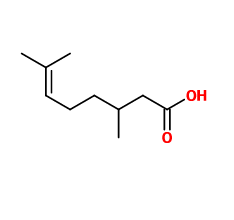
Photo credits: ScenTree SAS
Do you sell any of the raw materials? Would you like to let our users know?
Send an email to fournisseurs@scentree.coto learn about our advertising opportunities.
Do you sell any of the raw materials? Would you like to let our users know?
Send an email to fournisseurs@scentree.coto learn about our advertising opportunities.
General Presentation
-
CAS N° : 502-47-6
-
EINECS number : 207-939-7
-
FEMA number : 3142
-
FLAVIS number : 08.036
-
JECFA number : 1221
-
Appearance : Colorless liquid
-
Density : 0,93
-
Volatility : Heart/Base
-
Price Range : €€€
Physico-chemical properties
-
Molecular formula : C10H18O2
-
Molecular Weight : 170,25 g/mol
-
Log P : 2,84
-
Fusion Point : Donnée indisponible.
-
Boiling Point : 257°C
-
Detection Threshold : Donnée indisponible.
-
Optical rotation : Donnée indisponible
-
Vapor pressure : Donnée indisponible
-
Refractive Index @20°C : Donnée indisponible
-
Acid Value : Donnée indisponible.
-
Flash Point : 163,2°C
Uses
Uses in perfumery :
Year of discovery :
Data not available.
Natural availability :
Found in cardamom
Isomerism :
Citronellic Acid has an asymmetric carbon which gives origin to two possible enantiomers for this molecule. It is nevertheless a mixture of its isomers which is used in perfumery.
Synthesis precursor :
Citronellic Acid is used for the synthesis of several citronellic esters. A catalyzed reaction with ethanol allows for example to form Ethyl Citronellate.
Synthesis route :
Citronellic Acid is obtained by oxidation of Citronellal. This synthesis can use a Pinnick's Oxidation reaction. This oxidation takes place in two steps. First step, chlorous acid is synthetized by reaction between sodium chlorite and sodium dihydrogenphosphate. The second stage brings the chlorous acid into contact with the Citronellal, making its functional carbon more electrophilic. It can therefore undergo nucleophilic attack by the chlorite ion formed. A release of hypochlorous acid during a concerted mechanism finally allows citronellal acid to be formed.
Regulations & IFRA
Allergens :
This ingredient does not contain any allergen.
IFRA 51th :
This ingredient is not restricted for the 51th amendment


